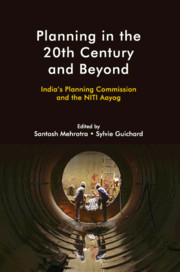Book contents
- Frontmatter
- Contents
- List of Figures
- List of Tables
- List of Abbreviations
- 1 Planning for a 21st Century India
- Part I Origins: Ideas and Ideology
- 2 From Economists to Historians: Studying the Planning Commission, 1950–2014
- 3 The Long Road to Indian Economic Planning (until 1950)
- 4 Ideas and Origins of the Planning Commission in India
- Part II Changes and Continuity: Development and Adaptation of Planning and the Planning Commission
- 5 The Planning Commission and Education
- 6 Addressing Agrarian Distress: Sops versus Development
- 7 Economic Planning after Economic Liberalization: Between Planning Commission and Think Tank NITI, 1991–2015
- 8 Planning Commission: Obiter Dictum
- 9 On a Revived Planning Commission
- Part III Planning Beyond the Planning Commission
- 10 Make in India
- 11 Manufacturing: The Cornerstone of a Planning Strategy for the 21st Century
- 12 Fiscal Planning to Sustain Growth and Poverty Reduction
- 13 Plan, but Do Not Over-plan: Lessons for NITI Aayog
- 14 Why Does India Need a Central Planning Institution in the 21st Century?
- Notes on Contributors
- Index
- References
3 - The Long Road to Indian Economic Planning (until 1950)
Published online by Cambridge University Press: 04 April 2020
- Frontmatter
- Contents
- List of Figures
- List of Tables
- List of Abbreviations
- 1 Planning for a 21st Century India
- Part I Origins: Ideas and Ideology
- 2 From Economists to Historians: Studying the Planning Commission, 1950–2014
- 3 The Long Road to Indian Economic Planning (until 1950)
- 4 Ideas and Origins of the Planning Commission in India
- Part II Changes and Continuity: Development and Adaptation of Planning and the Planning Commission
- 5 The Planning Commission and Education
- 6 Addressing Agrarian Distress: Sops versus Development
- 7 Economic Planning after Economic Liberalization: Between Planning Commission and Think Tank NITI, 1991–2015
- 8 Planning Commission: Obiter Dictum
- 9 On a Revived Planning Commission
- Part III Planning Beyond the Planning Commission
- 10 Make in India
- 11 Manufacturing: The Cornerstone of a Planning Strategy for the 21st Century
- 12 Fiscal Planning to Sustain Growth and Poverty Reduction
- 13 Plan, but Do Not Over-plan: Lessons for NITI Aayog
- 14 Why Does India Need a Central Planning Institution in the 21st Century?
- Notes on Contributors
- Index
- References
Summary
The state of opinion which governs a decision on political issues is always the result of a slow evolution, extending over long periods and proceeding at many different levels. New ideas start among a few and gradually spread until they become the possession of a majority who know little of their origin.
—Friedrich Hayek, The Constitution of LibertyIntroduction
The history of ideas has unfortunately been a fading concern among economists. Modern political economy primarily focuses on the role of special interests in determining public policy. These special interest coalitions are seen to have a stranglehold over the policy process. The most pessimistic variants of this view virtually rule out the possibility of policy reforms unless there is an exogenous shock that undermines the dominant coalition of interests. The role of ideas as instruments that loosen such political constraints over the long run is often ignored (Rodrik 2013). Yet policy debates have important effects on the subsequent direction of economic policy.
In a similar vein, the Indian tryst with centralized national planning was preceded by several decades of intense discussions within the Indian nationalist movement about the contours of economic policy. There was a wide agreement among nationalists that the state has to support industrialization in countries such as India that were late entrants in the development process. Their arguments constituted both a critique of colonial economic policy as well as an attempt to learn from the experiences of countries as diverse as Germany, Japan, and the Soviet Union that depended on institutional innovations to begin the process of capital accumulation. This chapter will show how the economic ideas prevalent in the Indian nationalist mainstream created the intellectual conditions for the eventual establishment of the Planning Commission in 1950.
What began as a sharp critique of British colonial practice, in the early years of modern Indian nationalism after the revolt of 1857, later evolved into a broad consensus among Indian nationalists that the state should assist the industrialization drive that would be necessary to break the iron grip of mass poverty. However, there was also a gradual evolution in the consensus about what would be the principal instrument for such state-led industrialization.
- Type
- Chapter
- Information
- Planning in the 20th Century and BeyondIndia's Planning Commission and the NITI Aayog, pp. 43 - 60Publisher: Cambridge University PressPrint publication year: 2020
References
- 1
- Cited by

